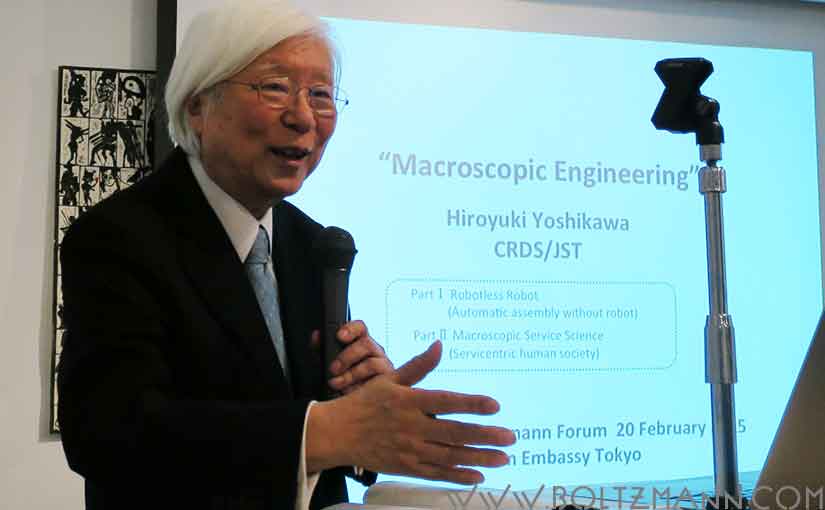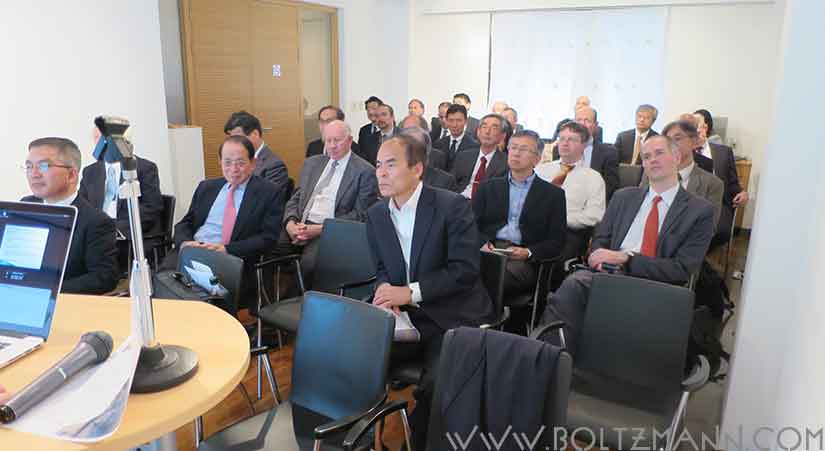Macroscopic Engineering
Hiroyuki Yoshikawa
keynote talk given at the 7th Ludwig Boltzmann Forum, Tokyo, 20 February 2015

by Hiroyuki Yoshikawa, Pioneer of robotics and precision manufacturing, Emeritus President of the University of Tokyo, Japan Prize 1997
summary by Gerhard Fasol – discussions at the end of this page
Part I: Robotless Robot (automatic assembly without robot)
For many engineering processes the interaction of geometrical shapes is important.
“Stable states” are states where for example triangles are placed with their sides in contact. As an example, if we consider two triangles, we have 9 stable states and 36 possible transitions.
Let us consider interactions between cylinders and holes in a plate – such as situation could arise in an industrial process. In this case we have metastable states, where the cylinders are upright, lying on their side, or placed oblique in one of the holes, and we have stable states, where the cylinders rest in on one of the holes.
We can consider an experiment where we have cylinders on a plate with several holes, and subject the plate to vibrations. Depending on the magnitude of vibrations, the cylinders will move around and may end up all placed in holes, which would be the finished product of this thought experiment.
The distribution of energy of cylinders at collisions between cylinders and the disc follows a Boltzmann Distribution.
Part II: Macroscopic Service Science (Servicentric human society)
Reconceptualization of manufacturing
Hypothesis: Service makes a society
The basic reason why human beings live together and work collectively or socially is that their mutual services are essential for their survival on earth. Humans cannot live alone.
Lemma: Manufacturing industry is part of the service industry.
In the service industry, a service donor (e.g. a server in a restaurant) manufactures a function and simultaneously delivers this as a service to a recipients (customer).
In the manufacturing industry, a donor manufactures functions which are embedded into products, which are delivered to recipients at a later time.
Basic structure of primitive service
- Service design:
- motivation
- design
- function
- design
- service
- Product design:
- motivation
- design
- function
- design
- product
- use (service)
- Primitive service: medical service at home e.g. mother-child
- Amplified service: medical service at hospital by a highly trained doctor using medical equipment and know-how
- Amplifiers: life science, medical skills, medical equipment, hospital facilities, IT
- Donate a service, e.g. a vegetable dish
- This service consists of three primitive services:
- produce food (donor: farmer, vehicle: fields, vegetables, recipient: wholesaler)
- sales service (donor: retailer, recipient: purchaser)
- cooking service (donor: cook, vehicle: dishes, recipient: eater)
- vehicle is a medium for the service. Tool is a typical vehicle
The flow of services can be seen as similar to flow in fluid dynamics: services flow from donor through a service pipe to recipients.
A donor’s motivation (subjective) is transformed into function (objective) at the first stage of service design. Function is input to themselves (donor) increasing the potential of latent function. When the potential exceeds the recipient’s potential of latent function, a service starts. Motivation is subjective, while function is objective (see: Social Theory and Social Structure by Robert K. Merton)
Replacing GDP by the total functional flow (services in a society) as an indicator for wealth of society
Motivation of a donor increases its latent function and when it exceeds the latent function of a recipient, function flow of service starts. Rate of flow is proportional to the functional gap, and admittance of the path.
A society is composed of people with different latent function of a kind. Each member has its capacity of receiving the function. As a result, the system of functional flow in the society is determined.
Services make a society.
From “manufacturing a product” to “manufacturing amplifiers on service network”
Our industrial society can be seen of the sum of a primitive service-only society PLUS manufacturing industries, resulting in amplified services.
As an example:
Industrial products and know-how amplify simple services.
Chains of primitive services

Copyright (c) 2015 Eurotechnology Japan KK All Rights Reserved
Leave a Reply